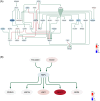Sex-dependent molecular landscape of Alzheimer's disease revealed by large-scale single-cell transcriptomics
- PMID: 39737748
- PMCID: PMC11848167
- DOI: 10.1002/alz.14476
Sex-dependent molecular landscape of Alzheimer's disease revealed by large-scale single-cell transcriptomics
Abstract
Introduction: Alzheimer's disease (AD) shows significant sex differences in prevalence and clinical manifestations, but the underlying molecular mechanisms remain unclear.
Methods: This study used a large-scale, single-cell transcriptomic atlas of the human prefrontal cortex to investigate sex-dependent molecular changes in AD. Our approach combined cell type-specific and sex-specific differential gene expression analysis, pathway enrichment, gene regulatory network construction, and cell-cell communication analysis to identify sex-dependent changes.
Results: We found significant sex-specific gene expression patterns and pathway alterations in AD. Male astrocytes showed changes in cell death pathways, with RPTOR as a key regulator, while female astrocytes had alterations in Wnt signaling and cell cycle regulation. Cell-cell communication analysis uncovered sex-specific intercellular signaling patterns, with male-specific impacts on apoptosis-related signaling and female-specific alterations in Wnt and calcium signaling.
Discussion: This study reveals sex-dependent gene expression patterns, pathway alterations, and intercellular communication changes, suggesting the need for sex-specific approaches in AD research.
Highlights: Single-cell transcriptomics reveals significant sex-specific molecular signatures in Alzheimer's disease (AD). Male astrocytes show enhanced modulation of apoptotic and cell death pathways in AD; female astrocytes exhibit distinct alterations in Wnt signaling and cell-cycle regulation. Sex-dimorphic changes in mitochondrial gene expression are observed in excitatory neurons, suggesting divergent energy metabolism profiles may contribute to AD sex differences. RPTOR is identified as a key regulator of male-specific changes in astrocytes, implicating the mechanistic target of rapamycin pathway in sex-dependent AD pathology. New cell-cell communication analyses reveal sex-specific patterns of intercellular signaling, providing insights into how cellular interactions may differentially contribute to AD pathology in males and females.
Keywords: Alzheimer's disease; apoptosis; cell death; network analysis; pathway analysis; sex differences; single‐cell sequencing; transcriptome analysis.
© 2024 The Author(s). Alzheimer's & Dementia published by Wiley Periodicals LLC on behalf of Alzheimer's Association.
Conflict of interest statement
The authors have declared that no competing interests exist. Author disclosures are available in the supporting information.
Figures




Similar articles
-
Single-Cell Cortical Transcriptomics Reveals Common and Distinct Changes in Cell-Cell Communication in Alzheimer's and Parkinson's Disease.Mol Neurobiol. 2025 Mar;62(3):2655-2673. doi: 10.1007/s12035-024-04419-7. Epub 2024 Aug 15. Mol Neurobiol. 2025. PMID: 39143450 Free PMC article.
-
Sex-Stratified Single-Cell RNA-Seq Analysis Identifies Sex-Specific and Cell Type-Specific Transcriptional Responses in Alzheimer's Disease Across Two Brain Regions.Mol Neurobiol. 2022 Jan;59(1):276-293. doi: 10.1007/s12035-021-02591-8. Epub 2021 Oct 20. Mol Neurobiol. 2022. PMID: 34669146 Free PMC article.
-
Glial changes and gene expression in Alzheimer's disease from snRNA-Seq and spatial transcriptomics.J Alzheimers Dis. 2025 May;105(2):646-665. doi: 10.1177/13872877251330320. Epub 2025 Apr 23. J Alzheimers Dis. 2025. PMID: 40267277
-
The role of microRNAs in understanding sex-based differences in Alzheimer's disease.Biol Sex Differ. 2024 Jan 31;15(1):13. doi: 10.1186/s13293-024-00588-1. Biol Sex Differ. 2024. PMID: 38297404 Free PMC article.
-
Revealing cell vulnerability in Alzheimer's disease by single-cell transcriptomics.Semin Cell Dev Biol. 2023 Apr;139:73-83. doi: 10.1016/j.semcdb.2022.05.007. Epub 2022 May 24. Semin Cell Dev Biol. 2023. PMID: 35623983 Review.
Cited by
-
Temporal transcriptomic changes in the THY-Tau22 mouse model of tauopathy display cell type- and sex-specific differences.Acta Neuropathol Commun. 2025 May 7;13(1):93. doi: 10.1186/s40478-025-02013-z. Acta Neuropathol Commun. 2025. PMID: 40336141 Free PMC article.
-
Identification of HIBCH and MGME1 as Mitochondrial Dynamics-Related Biomarkers in Alzheimer's Disease Via Integrated Bioinformatics Analysis.IET Syst Biol. 2025 Jan-Dec;19(1):e70018. doi: 10.1049/syb2.70018. IET Syst Biol. 2025. PMID: 40286336 Free PMC article.
-
Special Issue: "New Trends in Alzheimer's Disease Research: From Molecular Mechanisms to Therapeutics: 2nd Edition".Int J Mol Sci. 2025 Jul 25;26(15):7175. doi: 10.3390/ijms26157175. Int J Mol Sci. 2025. PMID: 40806308 Free PMC article.
-
Tirzepatide: a novel therapeutic approach for Alzheimer's disease.Metab Brain Dis. 2025 Jun 11;40(5):221. doi: 10.1007/s11011-025-01649-z. Metab Brain Dis. 2025. PMID: 40498212 Free PMC article. Review.
References
MeSH terms
Grants and funding
LinkOut - more resources
Full Text Sources
Medical

